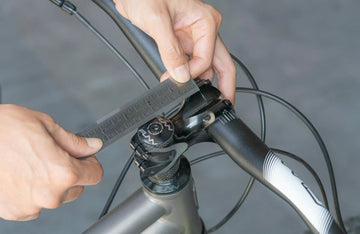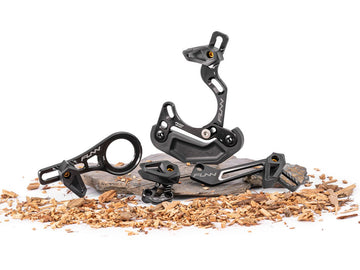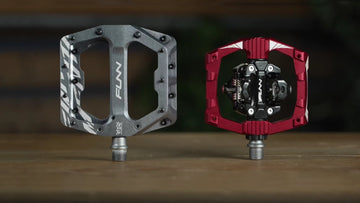
The bike stem length is a critical component when it comes to achieving a comfortable and efficient riding experience. It plays a significant role in determining your riding posture, bike handling, and overall comfort on the bike. Choosing the right stem length is essential to prevent discomfort and potential injuries caused by an ill-fitting bike.
If you’ve ever found yourself struggling with determining the ideal bike stem length, you’ve come to the right place! In this guide, we will provide a detailed instruction on how to measure your mountain bike stem length, and then walk you through the process of how to choose the most suitable stem length for your bike. Additionally, we will introduce different lengths of mountain bike stem. Say goodbye to the guesswork and optimize your cycling experience.
NOTE: THIS BLOG FOCUSES ON MOUNTAIN BIKE STEMS
This blog is dedicated solely to mountain bike stems, crucial for optimal handling and comfort in off-road cycling.
WHY BIKE STEM LENGTH MATTERS?
The length of your bike stem directly affects the position of your handlebars and, consequently, your body posture on the bike. Making sure to choose the proper length to reach a better cycling experience.
Riding Comfort
The right stem length helps you achieve a comfortable riding position. It allows you to adopt a more relaxed and natural posture, reducing the risk of discomfort, fatigue, and potential injuries. With the proper bike stem length, you’ll experience fewer aches and pains during and after your rides, enabling you to stay in the saddle longer and enjoy your cycling adventures.
Handling and Control
Precise handling and control of your bike are essential for navigating a variety of terrains and scenarios. An ill-fitting stem can make your bike feel twitchy or sluggish in response to your steering inputs. Choosing the right stem length ensures that your bike responds predictably to your commands, enhancing your riding experience and safety.
Efficiency
An appropriately sized stem contributes significantly to your pedaling efficiency and overall riding experience. It facilitates optimal power transfer from your body to the pedals, allowing you to generate more speed with less effort. Additionally, it aids in weight distribution, helping you maintain balance during climbs and descents.

MEASURING BIKE STEM LENGTH
Prior to selecting the optimal stem length, it is essential to begin by measuring the length of your bike stem. This measurement serves as a crucial foundation for deciding which stem length aligns with your specific needs and preferences, ultimately enhancing your overall cycling experience.

Locate the center of the handlebar clamp, which is where the handlebar attaches to the stem. This point should be at the exact center of the clamp. Similarly, identify the center of the steerer tube clamp, where the stem attaches to the bike’s fork.
Using your measuring tool such as ruler, measure tape or digital caliper, measure the distance between the center of the handlebar clamp and the center of the steerer tube clamp. Ensure that you measure from the center of one clamp to the center of the other clamp.
IDENTIFYING COMMON MOUNTAIN BIKE STEM LENGTHS
In the following section, we will provide a concise overview of common bike stem lengths, ranging from short to long, and guide you in choosing the optimal stem length to match your riding style.
Short Stem (35mm to 50mm):
Providing lightning-quick and highly responsive handling, which makes them particularly well-suited for navigating technical and steep terrain. But it may result in a more aggressive riding position and reduced stability, and may lead to discomfort during long rides.
Medium Stem (60mm to 80mm):
Medium stem strikes a balance between the agility of short stem and the stability of long stem, making it suitable for a wide range of conditions. However, it may not be the ideal choice for specific disciplines like downhill riding and cross-country racing due to its lack of responsive handling and efficiency compared to other lengths of stem.
Long Stem (90mm to 100mm+):
Offering optimal stability and efficiency in climbing even at high speed, the long stem can greatly reduce upper body fatigue, which makes it a popular choice for longer rides. But long stems may also cause slower steering response which may not be suitable for technical or challenging terrains.

CHOOSING AN IDEAL STEM LENGTH BASED ON RIDING PREFERENCE
Choosing the ideal bike stem length depends on several crucial factors that contribute to your overall riding experience. To ensure a harmonious fit between you and your bike, take into account the following considerations:
Riding Style
For riders favoring technical descents, shorter stems ranging offer quick and responsive handling, ideal for navigating tricky terrain. If you prefer cross-country trails, a medium stem features a balance between agility and stability.
Riders embarking on endurance rides or seeking long-distance comfort can benefit from a long stem. These stems offer optimal stability and enhance efficiency during climbs, reducing upper body fatigue.
Body Geometry
Taller riders often find longer stems more accommodating, as they promote a stretched-out riding posture, providing room for comfort during extended rides. Conversely, shorter riders may opt for shorter stems to maintain a balanced and comfortable position on the bike.
Terrain
If you frequently navigate technical descents, consider a short stem to enhance maneuverability and quick handling. For smooth and straight paths, such as those found on road rides or gravel routes, a long stem can contribute to stability and efficiency.

TESTING AND ADJUSTING
After determining the appropriate bike stem length and successfully installing it on your bike, it’s crucial to conduct a suitability test. Here are key aspects to consider during this evaluation:
Comfort Assessment:
Conducting a test ride is essential to evaluate for any discomfort or strain. If you experience any discomfort, consider making adjustments to the stem length accordingly.
Handling Evaluation:
Carefully examine your bike’s handling characteristics. Ensure it responds adeptly to your steering inputs and maintains stability throughout your rides.
Efficiency Observation:
Pay close attention to your pedaling efficiency, particularly during climbs. An adequately sized stem should notably enhance your power transfer.

If you detect any discrepancies in the stem length’s suitability, promptly making the necessary adjustments is essential to prevent potential injuries and ensure a safe and gratifying cycling experience. For more information on how to fine-tune your bike stem, check out our comprehensive guide: “Steer Clear of Mistakes: A Guide to Replacing Your Threadless Bike Stem”
CONCLUSION
In conclusion, selecting and measuring the right bike stem length is a crucial aspect of optimizing your cycling experience.
Stem length significantly influences your comfort, control, and overall performance on various terrains. By understanding the importance of stem length, considering factors like riding style, terrain, body geometry, and bar clamp diameter, and following the steps to choose and measure the ideal stem length accurately, you can fine-tune your bike setup for maximum comfort and efficiency.
With the right stem length, you can ride with confidence, knowing that your bike is tailored to your preferences and needs. So, measure wisely, ride comfortably, and enjoy your cycling adventures to the fullest!






